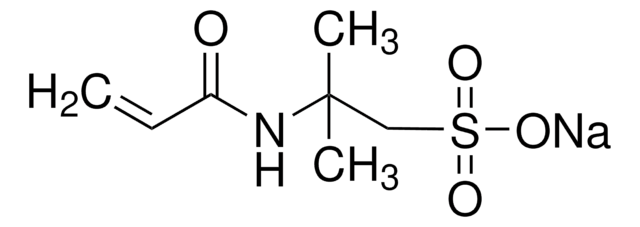191973
Poly(2-acrylamido-2-methyl-1-propanesulfonic acid) solution
average Mw 2,000,000, 15 wt. % in H2O
Synonyme(s) :
2-Acrylamido-2-methyl-1-propanesulfonic acid polymer, 2-Acrylamido-2-methylpropanesulfonic acid polymer, PolyAMPS
About This Item
Produits recommandés
Poids mol.
average Mw 2,000,000
Concentration
15 wt. % in H2O
pH
1.0-3.0
Tension de surface
79.8 dyn/cm, 1 wt. %
Viscosité
~200,000 cP, Brookfield RVT(lit.)
Indice d'acide
41‑45 mg KOH/g
Chaîne SMILES
CC(C)(CS(O)(=O)=O)NC(=O)C=C
InChI
1S/C7H13NO4S/c1-4-6(9)8-7(2,3)5-13(10,11)12/h4H,1,5H2,2-3H3,(H,8,9)(H,10,11,12)
Clé InChI
XHZPRMZZQOIPDS-UHFFFAOYSA-N
Catégories apparentées
Application
Caractéristiques et avantages
Mention d'avertissement
Danger
Mentions de danger
Conseils de prudence
Classification des risques
Skin Corr. 1A
Code de la classe de stockage
8A - Combustible corrosive hazardous materials
Classe de danger pour l'eau (WGK)
WGK 3
Point d'éclair (°F)
Not applicable
Point d'éclair (°C)
Not applicable
Certificats d'analyse (COA)
Recherchez un Certificats d'analyse (COA) en saisissant le numéro de lot du produit. Les numéros de lot figurent sur l'étiquette du produit après les mots "Lot" ou "Batch".
Déjà en possession de ce produit ?
Retrouvez la documentation relative aux produits que vous avez récemment achetés dans la Bibliothèque de documents.
Les clients ont également consulté
Notre équipe de scientifiques dispose d'une expérience dans tous les secteurs de la recherche, notamment en sciences de la vie, science des matériaux, synthèse chimique, chromatographie, analyse et dans de nombreux autres domaines..
Contacter notre Service technique




![Poly[bis(2-chloroethyl) ether-alt-1,3-bis[3-(dimethylamino)propyl]urea] quaternized, solution 62 wt. % in H2O](/deepweb/assets/sigmaaldrich/product/structures/139/843/f0b4a2ac-de44-4fb5-ab36-a700daaf8aa5/640/f0b4a2ac-de44-4fb5-ab36-a700daaf8aa5.png)







![Poly[(2-ethyldimethylammonioethyl methacrylate ethyl sulfate)-co-(1-vinylpyrrolidone)] average Mw <1,000,000 by GPC, 20 wt. % in H2O](/deepweb/assets/sigmaaldrich/product/structures/334/533/03fcaede-76a6-4b5a-a992-9565ea1ace4a/640/03fcaede-76a6-4b5a-a992-9565ea1ace4a.png)

